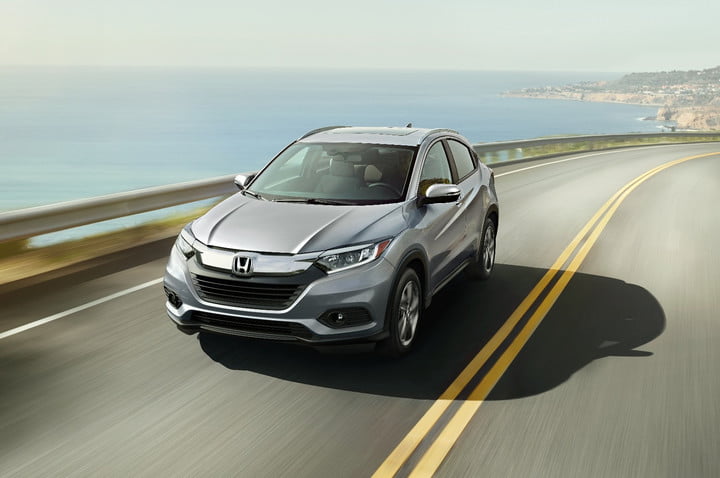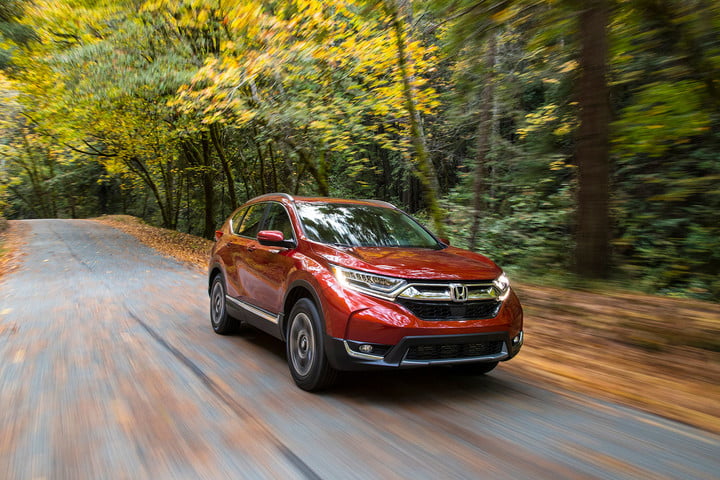Honda HR-V vs. Honda CR-V | Price, Specs, Performance, and More

Now in its fifth generation, Honda’s CR-V has become one of the best-selling cars in America. It’s gotten significantly bigger over the past 20 years, however. It’s only natural, then, that the Japanese firm would try to keep the momentum going by introducing a smaller crossover named the HR-V. While the two models overlap in some areas, they’re completely different cars aimed at different sets of buyers. Read on for a comparison highlighting their design, technology, performance, and fuel economy.
Tech features
Think of the HR-V as a Honda Fit on stilts. Befitting of its entry-level status, it comes with a relatively basic level of equipment that includes a four-speaker stereo, Bluetooth connectivity, and a 5-inch color LCD screen. The Sport trim level adds a six-speaker sound system and a 7-inch touchscreen, while the range-topping Touring model benefits from navigation. You’ll need to step up to the Sport model if you want to get Apple CarPlay or Android Auto, too.
- 1.
2018 Honda CR-V - 2.
2019 Honda HR-V Sport
It’s the same story if you’re looking at a CR-V. The base model comes with the same 5-inch LCD screen as the cheapest HR-V, and you need explore the upper echelons of the trim hierarchy to get features like a six-speaker sound system, a 7-inch touchscreen, and navigation. The top three trim levels come standard with Android Auto and Apple CarPlay compatibility.
Performance and fuel economy
Honda only offers the HR-V with a 1.8-liter, four-cylinder engine rated at 141 horsepower and 127 pound-feet of torque. Honda eliminated the six-speed manual transmission for the 2019 model year, meaning every HR-V regardless of trim level comes with a continuously variable transmission (CVT). Front-wheel drive comes standard and all-wheel drive is available at an extra cost.
The base CR-V comes with a 2.4-liter four-cylinder that provides 184 hp and 180 lb-ft. of torque. It’s an older engine, which explains why it only equips the entry-level model. We’d wager it’s not long for this world, either. The three higher trim levels surf the industry’s downsizing wave with a turbocharged 1.5-liter four shared with the Civic, among other models. In spite of its smaller displacement, it still delivers 190 hp and 179 lb-ft. of torque.

Honda no longer makes a stick available on the CR-V, so a CVT is the only transmission option. Front-wheel drive comes standard, and all-wheel drive is available at an extra cost regardless of which engine occupies the space under the hood.
The HR-V returns 28 miles per gallon in the city, 34 mpg on the highway, and 30 mpg combined when equipped with front-wheel drive. Adding all-wheel drive lowers those figures to 27, 31, and 29, respectively.
The Environmental Protection Agency (EPA) rates the CR-V’s base engine at 26 mpg in the city, 32 mpg on the highway, and 28 mpg in a combined cycle when it spins only the front wheels. Adding all-wheel drive lowers mileage to 25, 31, and 27, respectively. Buyers who order the turbo four can expect to see 28 mpg in the city, 34 mpg on the highway, and 30 combined. All-wheel drive models take a small hit: 27, 33, and 29, respectively.
Interior and exterior design
Honda introduced the HR-V in 2015 as a 2016 model. At the time, the model fell in line with the firm’s design language by adopting styling cues such as sharp headlights that flank a gloss-black insert accented by a strip of chrome trim. Character lines chiseled into the side panels reduce visual mass, which explains why the HR-V looks less like an awkwardly tall hatchback and more like crossover than some of its rivals. Inside, every button, switch, and knob is placed right where you expect it to be. The driver faces a three-spoke steering wheel and an analog instrument cluster. The center stack houses the touchscreen that displays the infotainment system and the climate control panel.
- 1.
2018 Honda CR-V - 2.
2019 Honda HR-V Sport
The current CR-V went on sale more recently, so it wears a much more contemporary design. The front end looks more muscular than before, and it points to the direction Honda’s design department will take in the coming years. The SUV-like proportions clear up a generous amount of space in the cabin for both passenger and gear. Step inside and you’ll be able to tell right off the bat that it’s a more modern car. It wears a cleaner, more minimalist design than its smaller sibling. Some models even boast wood trim, a feature which shows the CR-V has moved upmarket since its inception.
The HR-V stretches 169 inches from bumper to bumper, 63.2 inches tall, and 69.8 inches wide. In comparison, the CR-V’s measurements check in at 180, 66.1, and 73, respectively. Clearly, the C stands a class above the H on R-V planet.
Safety
Every HR-V regardless of trim level comes with front, side, and side curtain airbags in addition to traction and stability control systems. The top two trim levels also benefit from a blind spot monitoring system. Driving aids like a road departure mitigation system, adaptive cruise control, collision mitigation braking, and lane departure warning come standard on EX models and up.

The CR-V also gets front, side, and side curtain airbags, plus traction and stability control systems. Buyers can order Honda Sensing, too, a suite of electronic driving aids that include collision mitigation (which brakes when it detects a crash is imminent), road departure mitigation (which emits visual and audible warnings if it senses the car is veering off the road), adaptive cruise control with low-speed follow, and lane-keeping assist.
Pricing
As Honda’s entry-level soft-roader, the HR-V carries a base price of $20,520. At the other end of the spectrum, the range-topping Touring trim commands $28,540. The base CR-V starts at $24,150, while the top-spec Touring trim level kicks off at $32,650. None of the aforementioned figures include a mandatory $995 destination charge, which is like shipping and handling in the car world.
Key rivals
Honda placed the HR-V in the cutthroat world of small crossovers. It competes on the same turf as the Chevrolet Trax, the Jeep Renegade, the Mazda CX-3, and the Fiat 500X, among others. The CR-V’s segment is even more competitive. Rivals include the Mazda CX-5, the Toyota RAV4, the Volkswagen Tiguan, and the Ford Escape.








